 author
authorDiscover the Best Books Written by Eve Curie
Ève Denise Curie Labouisse was a French and American writer, journalist, and pianist. Ève Curie was the younger daughter of Marie Skłodowska-Curie and Pierre Curie. Her sister was Irène Joliot-Curie, and her brother-in-law was Frédéric Joliot-Curie. She worked as a journalist and authored her mother's biography Madame Curie and a book of war reportage, Journey Among Warriors.
From the 1960s, she committed herself to work for UNICEF, providing help to children and mothers in developing countries. Ève was the only member of her family who did not choose a career as a scientist and did not win a Nobel Prize. However, her husband, Henry Richardson Labouisse Jr., did collect the Nobel Peace Prize in 1965 on behalf of UNICEF, completing the Curie family legacy of five Nobel Prizes.
Ève Denise Curie was born in Paris, France, on December 6, 1904. She was the younger daughter of the scientists Marie and Pierre Curie, who also had another daughter Irène (born 1897). Ève did not know her father, who died in 1906 in an accident, run over by a horse cart. After this accident, Marie Curie accepted her husband's teaching position at La Sorbonne. Her father-in-law, Dr. Eugène Curie, had moved in with the family when his wife died, and he took care of the children while Pierre and Marie, and then Marie only, went to work.
When he died in 1910, Marie Curie was forced to bring up her daughters herself with the help of governesses. Even though Ève confessed later that as a child she had suffered from a lack of sufficient attention from her mother and that only later, in her teens, she developed a stronger emotional bond with her, Marie took great care for the education and development of interests of both her daughters.
Whereas Irène followed in her mother's footsteps and became an eminent scientist (she was awarded the Nobel Prize in Chemistry with her husband Frédéric Joliot-Curie in 1935), Ève showed more artistic and literary interests. Even as a child, she displayed a particular talent for music. Whatever the weather, they went on long walks and rode on bikes. They went swimming in summer, and Marie had gymnastics equipment installed in the garden of their house in Sceaux, Hauts-de-Seine. Ève and Irène also learned sewing, gardening, and cooking.
Although the girls were French nationals (Ève later became American citizens), and their first language was French, they were familiar with their Polish origin and spoke Polish. In 1911 they visited Poland (the southern part, which was then under Austrian rule). During their visit to Poland, they also rode horses and hiked in the mountains. In 1921, Ève set off on her first journey across the Atlantic Ocean: that spring, she sailed with her sister and mother on board the ship RMS Olympic to New York City. Marie Curie, a two-time laureate of the Nobel Prize and the discoverer of radium and polonium, was welcomed there with all due ceremony; her daughters were also very popular with American high society.
Radiant at parties and joyous, Ève was dubbed by the press "the girl with radium eyes." During the trip, Ève and Irène also acted as their mother's "bodyguards" – Marie, usually focused on research work and preferring a simple life, did not always feel comfortable facing the homage paid to her. While in the United States, Marie, Irène, and Ève met President Warren G. Harding in Washington, D.C., saw Niagara Falls, and went by train to see the Grand Canyon. They returned to Paris in June 1921.
Ève, like her sister Irène, graduated from the Collège Sévigné, a nondenominational private high school in Paris, where she obtained her baccalaureate in 1925. Meanwhile, she also improved her piano skills and gave her first concert in Paris in 1925. Later, she performed on stage many times, giving concerts in the French capital, in the provinces, and in Belgium.
After Irène married Frédéric Joliot in 1926, Ève stayed with her mother in Paris, taking care of her and accompanying her on trips throughout France, Italy, Belgium, and Switzerland. In 1932, they also accompanied the President of Czechoslovakia, Tomáš Masaryk, on his trip to Spain. Although she loved her mother, Ève had a quite different personality from her (and from her sister Irène).
She was not interested in science, preferring the humanities. Unlike her mother, she was always attracted to refined life. Whereas Marie usually wore simple, black dresses, Ève always cared about smart clothes, wore high-heeled shoes and make-up, and loved shining at parties. However, both Ève and Irène nursed their mother with devotion until her death. Marie, ill with aplastic anemia, probably caused by her long-term exposure to radium, died on July 4, 1934. Although now (in 2021), it is believed that it was the long-term exposure to Roentgen Rays during WWI that caused aplastic anemia, as Marie for 4 years assisted in examining wounded patients through Roentgen machines.
Best author’s book




















